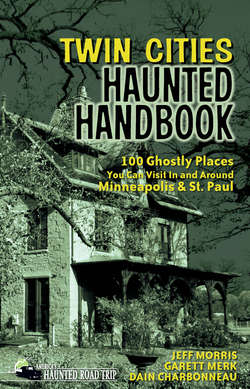Читать книгу Twin Cities Haunted Handbook - Jeff Morris - Страница 18
На сайте Литреса книга снята с продажи.
ОглавлениеFORT SNELLING
Historic Fort Road, St. Paul, Minnesota 55111
directions
From downtown St. Paul, take I-35E South for about 3.5 miles until you reach exit 103B, the MN-5/ West 7th Street exit. At the end of the exit ramp, turn right onto Fort Road and follow that for another 2.5 miles. Take the MN-55 West ramp and then take the ramp towards Fort Snelling. Stay straight to go onto Tower Road and then turn right onto Historic Fort Road. This road will take you onto the grounds and to the historic fort.
history
Construction began on this fort in 1820. It was constructed on a bluff overlooking both the Mississippi and Missouri Rivers and was used to control American interests in the area. Those stationed at the fort were there to make sure that the Native Americans did not attack European settlers and that the European settlers did not settle land that was not sanctioned by the federal government. Eventually, with the rapid growth of Minneapolis and St. Paul, the fort became unnecessary.
When the Civil War broke out, the fort was once again used to train soldiers and to defend the cities of Minneapolis and St. Paul. In 1862, an uprising of the Dakota tribe of Native Americans resulted in the Dakota War of 1862. A group of Dakota out on a hunting expedition came across and killed five European settlers because they blamed all whites for the treaty violations that had brought hard times upon the tribe. Fearing retaliation from Fort Snelling, the Dakota decided to kill as many settlers as they could in an attempt to drive them from the area permanently. They killed as many as 800 settlers before the uprising was quelled. They enslaved and tortured many more settlers before the war was over. Sixteen hundred Dakota were captured and imprisoned in a concentration camp on the grounds of Fort Snelling. Many died while imprisoned there; 303 more Dakota were sentenced to death. President Abraham Lincoln, upon reviewing the trials for the condemned men, decided that all but 39 of the men acted as if at war with the United States and therefore had not committed capital crimes. Thirty-eight of the 39 men were hung in the largest mass execution in American history.
The fort was used again during WW II but soon afterwards fell into disrepair. In 1960, the fort was listed on the National Register for Historic Places and was restored by the Minnesota Historical Society, which still runs the fort to this day.
ghost story
Both the park below the fort and the fort itself are reputed to be haunted. In the park below the fort where the concentration camp was located, people report being touched by unseen forces and hearing people talking in a language they do not understand. From the park, people also report strange things when looking up at the fort itself—figures dressed in 19th-century military uniforms in the windows and strange lights going up and down the stairs of the towers.
Inside of the building, people again get touched by invisible forces and experience intangible feelings of discomfort. They will feel as if they are being watched or as if there is something there that does not want them there. Others see figures walking through the corridors that mysteriously vanish without a trace.
visiting
From Memorial Day until Labor Day, the fort is open to the public every day of the week, except Monday, until 5 p.m. From Labor Day until Halloween, the fort is only open on Saturdays and only until 5 p.m. Admission is $10. This is your only chance to investigate the fort itself and experience the paranormal happenings within the fortified walls.
The park that surrounds the historic fort is open throughout the year and every day of the week. The park is only open until 4 p.m., though, so you would have to go before 4 p.m. if you are interested in looking up at the fort and perhaps seeing the apparition of a soldier looking back down at you.
